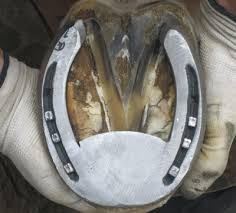
Feb 6, 2018 | Hoof Care, Shoeing
I’m going to let you in on a little secret: every few months my Docs and a bunch of farriers get together and spend a few hours learning from each other about the wild, weird world of horse shoes and feet. I think this is a great idea since I get an extra evening of humans entertaining me. I have also found exploring farrier trucks and trailers to be an enjoyable pastime. What I have learned from these evenings is: 1. Horses seem to have a lot of problems with their feet, 2. There are a whole bunch of ways to deal with said problems, 3. The problems encountered in Number 1 are best approached by a veterinary/farrier team. In my ongoing efforts to educate you humans about your horses, this week we’re going to talk about horse shoes.
Understanding the problem
In the realm of things done strangely, the equine foot takes the cake. While most of us have a foot made up of 4-5 different finger type things, the horse has to be different. They go with one finger, surround it with fingernail, and land on the tip. I’m not surprised problems happen. I am surprised at how diverse those problems can be. I’m also surprised at how much basic physics are involved in those problems. A little push here, a degree or two off there, add a bit of rotation to it, and Viola! You have one screwed-up foot.
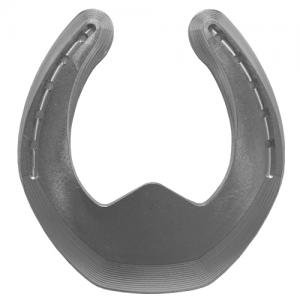 A deeper understanding of the problem
A deeper understanding of the problem
Putting the veterinarian and the farrier in the same location at the same time while watching the horse move lets them talk about what each one sees. The veterinarian may have found that the horse improves when the heels are blocked with lidocaine. The farrier noticed that the horse puts a whole lot of wear on the outside branch of the shoe. Looking at an x-ray of the foot together, the veterinarian sees some arthritis developing, and both of them notice that the joint space isn’t even across the coffin joint. Between the two of them, they can now talk about what may work to address the problem. Even better, when the Docs and the farriers work together, an x-ray can be taken during the shoeing process to make sure the shoe is exactly where it needs to be.
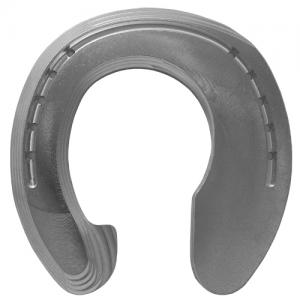 Put a shoe on it (or maybe not)
Put a shoe on it (or maybe not)
I have learned that doing the basics well is sooo important. That’s a free life lesson from Tony, right there. With feet that means a good trim. See several previous excellent blogs I’ve written about what a good trim looks like. Horses being horses, sometimes they need more than a good trim can offer. That’s where shoes come in. Shoes help protect areas from getting worn down too much. For example, a club-footed horse wears off their toe very quickly, which makes the club foot worse. A simple shoe protecting the toe can do wonders for these horses. Shoes can add support where it’s needed. For example, a horse who toes out will push their inside hoof wall under the foot. By setting the shoe a little bit to the outside of that inside wall, we keep that weight bearing where it’s supposed to be.
 New and Exciting stuff
New and Exciting stuff
Now for the exciting part of shoes! There are shoes available that help treat specific issues your horse may have. These shoes are based on how tendons, ligaments, joints, and bones interact in the leg. Then a dash of physics (ok, way more than a dash) is applied. This leads to a shoe with wide parts in some areas, skinny parts in other areas, and all kinds of odd looking things that all have a role to play. My Docs brought in an expert on these shoeing principles for one of these farrier parties. It was so fascinating! I never imagined horseshoeing could be so enthralling.
Want to be sure you’re doing all you can for your horse’s feet? My Docs are more than happy to talk feet with you ANYTIME!! And now I’m off to nap on a good book about equine anatomy.
Until next week,
Tony
[jetpack_subscription_form title="Subscribe to Whinny's Wisdoms"]
Tuesdays with Tony is the official blog of Tony the Office Cat at Springhill Equine Veterinary Clinic in Newberry, Florida. For more information, please call us at (352) 472-1620, visit our website at SpringhillEquine.com, or follow us on Facebook!

Oct 2, 2017 | Farriers, Feet, Hoof, Hoof Care, Shoeing
I’m going to revive a classic Tuesdays with Tony here: The April 2015 Everything You Ever Wanted To Know About Your Horse’s Feet. I’ll post a link to this at the bottom, don’t worry! I hear the Docs talking about feet a lot so it must be important. My understanding is that the ideal horse hoof shape is simple to understand, but not easy to achieve.
Who thought that was a good idea??
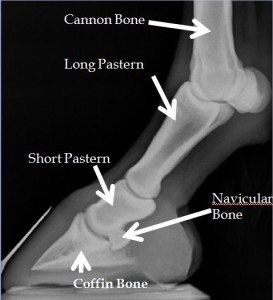
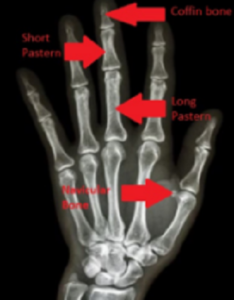 You humans have a thing you do with your middle finger. Horses one-up you: they walk on theirs! That’s right. The coffin bone is the tip of your middle finger. Feel the bones moving down your finger, back toward your hand, and you have the equivalent of the short pastern, long pastern, and cannon bone. You’ve got a navicular bone too, but only in your thumb. This whole ‘walking on one finger’ thing is why horses have so many lower leg problems.
You humans have a thing you do with your middle finger. Horses one-up you: they walk on theirs! That’s right. The coffin bone is the tip of your middle finger. Feel the bones moving down your finger, back toward your hand, and you have the equivalent of the short pastern, long pastern, and cannon bone. You’ve got a navicular bone too, but only in your thumb. This whole ‘walking on one finger’ thing is why horses have so many lower leg problems.
What’s a foot supposed to look like?
Walking on one finger means the hoof has to be balanced just right. If it isn’t, too much pressure gets put on one part of the anatomy. Excess pressure leads to badness. Here’s where ‘simple, but not easy’ comes in. On a freshly trimmed hoof (that’s important and I’ll tell you why in a minute), a line drawn at the widest part of the hoof should have 50% of the hoof in front of it, and 50% behind it. A line drawn down the center of the hoof from toe to heel should have 50% of the hoof on the inside, and 50% on the outside. In the pictures I’m using as an example here, one half of the foot is trimmed, and the other half isn’t. That will help you see the differences.
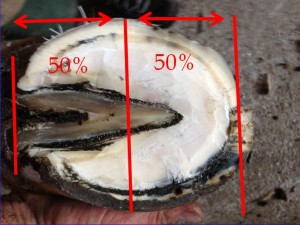
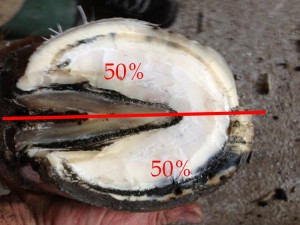 Now why did I say in a freshly trimmed foot? Take a look at where the heel is located on this hoof. It’s nearly ¾” farther forward on the untrimmed side, when compared to the trimmed side. That’s not because the farrier did it wrong 5 weeks ago, that’s because the foot grew forward. It’s what they do.
Now why did I say in a freshly trimmed foot? Take a look at where the heel is located on this hoof. It’s nearly ¾” farther forward on the untrimmed side, when compared to the trimmed side. That’s not because the farrier did it wrong 5 weeks ago, that’s because the foot grew forward. It’s what they do.
 After assessing the bottom of the hoof, pick up the leg. Put your hand underneath the end of the cannon bone, and let the hoof hang. Notice there are no human hands in this picture. That’s they way it’s supposed to be! When you hang the hoof like this, a line drawn down the center of the pastern and heels should be perpendicular to the bottom of the hoof.
After assessing the bottom of the hoof, pick up the leg. Put your hand underneath the end of the cannon bone, and let the hoof hang. Notice there are no human hands in this picture. That’s they way it’s supposed to be! When you hang the hoof like this, a line drawn down the center of the pastern and heels should be perpendicular to the bottom of the hoof.
My horse’s hoof looks nothing like this
There’s two reasons your horse’s foot doesn’t look this:
1. Conformation.
2. The Farrier.
Number 1 is WAY, WAY, WAY more common that number 2!
Crooked-legged horses end up with crooked feet. Your farrier’s job is to try to compensate for what Mother Nature did a less-than-ideal job of creating. For instance, if there’s more foot on the outside, your farrier will more aggressively trim and rasp this area to keep the foot from getting too off-kilter. However, sometimes the foot is too far off or the pressures of the job are too great. This is where shoes become necessary. A shoe will help your farrier compensate by preventing excess wear on parts of the foot, and allowing for support on other areas. Think that’s easy? There are approximately 1.3 million types of shoes (this may be an exaggeration) for horses. That alone tells me it ain’t easy!!
Got foot questions? Send in pictures of the bottom of your horse’s foot, a picture from the front, and one from the side taken at ground level, and my smart Docs will tell you what they see. To expedite the process, please include 1 bag of Temptations Savory Salmon cat treats with written instructions for the whole bag to be given to me (my minions think it’s appropriate to give me two or three treats at a time, which is ridiculous). You can also come and deliver them in person (and ask questions) at our Behavior Seminar this Thursday! I’m hosting the seminar here at the Clinic, so make sure you come scratch my ears. Oh, and learn about horse behavior, that too. That’s Thursday, October 5th at 6:30pm, right here at Springhill Equine Veterinary Clinic in Newberry. Just look for the big black cat!
Links to original posts:
Part 1: Everything You Ever Wanted To Know About Your Horse’s Feet
Part 2: Everything You Need to Know About Your Horses Feet
Tuesdays with Tony is the official blog of Tony the Clinic Cat at Springhill Equine Veterinary Clinic in Newberry, Florida. If you liked this blog, please subscribe below, and share it with your friends on social media! For more information, please call us at (352) 472-1620, visit our website at SpringhillEquine.com, or follow us on Facebook!
[jetpack_subscription_form title="Subscribe to Whinny's Wisdoms"]
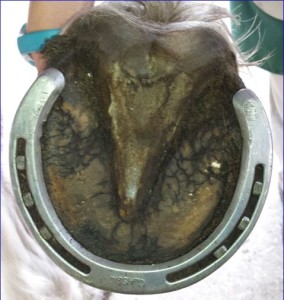
Apr 24, 2015 | Ailments, Feet, Hoof, Hoof Care, Lameness, Laminitis, Leg issues, Shoeing
Part 2: Everything You Need to Know About Your Horse’s Feet
So they made me do a little work between blogs but here is Part 2 of my exclusive report from the All You Need to Know About Your Horse’s Foot Seminar.
When you hear ‘break-over’ you should think of thunderclouds parting and the sun coming out, angels singing, a drink of water when you are really thirsty. It’s that important. Horses have multiple break-overs, but we are going to concentrate on the one at the front of the foot for now. A break-over is exactly what it sounds like. It’s the point at which the hoof comes off the ground during movement. The moment of break over is the hardest on the hoof structures. Every bit of that force is trying to tear the foot apart.
A good trim, according to the guidelines I talked about in Part I, will set up a good break-over. This point should be about ½” to ¾” in front of the tip of the coffin bone. Wait a minute… how is my farrier supposed to know where the tip of the coffin bone is located?? I don’t think they come equipped with x-ray vision! Most of the time your farrier will set the break-over at a point about ½” to ¾” in front of the tip of the frog. Sometimes the foot doesn’t seem to be doing what your farrier expects. X-rays of the foot will help your farrier see what the bones are doing inside the hoof. X-rays let us see if there is arthritis, injuries, or laminitis going on which may require special shoeing.
Visual Aids!
Let’s look at some feet and see if you can spot the problem. First up:

This guy definitely doesn’t have his heels back to the widest part of his frog and that’s with the shoe on. And if you look at the branches of the shoe you will see they aren’t even. The shoe is twisted on the foot. His break-over is also too far forward.
Next up:
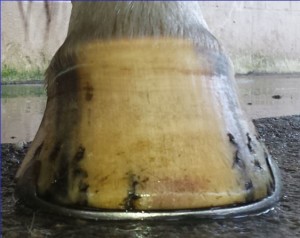
A line drawn down the center of this foot definitely won’t give you half inside and half outside.
This shoe…..Unless half this shoe was on one foot and half was on another foot it doesn’t make sense.
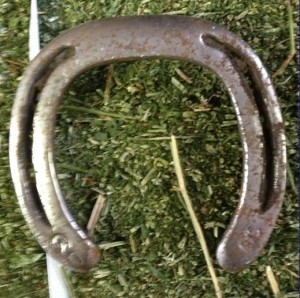
Now for the fun stuff. What happens when the foot has been trimmed and we can’t get the alignment the way we want it? We put a shoe on it!! So in answer to the barefoot question. Your horse can go barefoot if two things can happen: the foot can be balanced with a trim, and the work the horse is doing doesn’t unbalance the foot faster than it can grow to compensate.
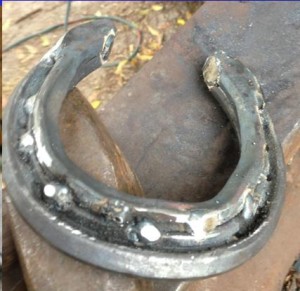
This shoe is an extreme example of break-over manipulation. It starts with a regular shoe. Bar stock is then welded to the inside. Then the shoe is nailed to the foot. The end result is a shoe that allows this horse to break-over anywhere he wants.
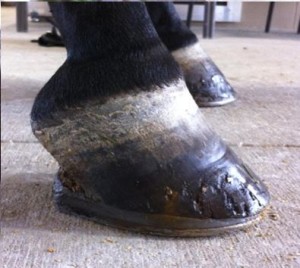
This horse is an example of the opposite end of the spectrum. This foot has been allowed to grow long to bring the break-over forward but notice the principles have still been applied. Now this foot is extra long since this horse is due to be shod but notice the foot is balanced and well supported. We can manipulate feet to make gaits we find appealing but it must be done correctly or we jeopardize the horse.
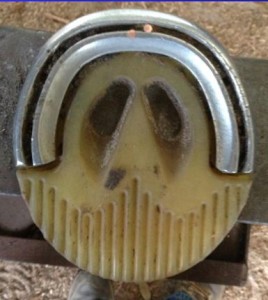
Ever get tired of your young horse pulling shoes? Or have a horse with really sore heels? This shoe, affectionately called the flip flop, fully supports the foot but is very forgiving of the hind foot grab. Most short coupled young horses go through a shoe pulling phase until they learn to wear shoes. It’s normal and should not be blamed on your farrier. Sore-heeled horses need some support since they hurt too bad to not have a shoe underneath them, but metal shoes can be too hard on them. The heels on these shoes offer them soft support.
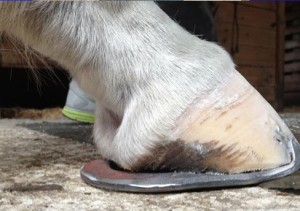
This shoe is an example of the compromises we have to make sometimes. This horse has a torn deep digital flexor tendon. This injury will heal best if we can take some of the tension off the tendon. A shoe like this helps reduce that tension but it has moved that pressure to the heels. Notice how the heel is curving under. This shoe can’t be used long term without causing significant hoof problems.
A quick note on some common Florida problems. This beautiful abscess is secondary to all the very wet weather we have been having. Using durasole, thrush buster, keratex hoof hardener or something similar on the foot will help it handle all that excess moisture. Sometimes no matter what we use on the foot they just stay way too wet. In that situation shoes may be the answer if only temporarily.
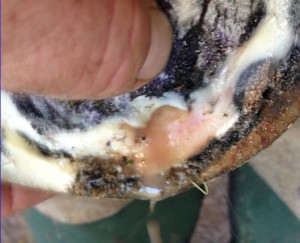
Along with abscesses, thrush is a common problem. The cattle mastitis ointment Today applied to the affected areas daily for a week and then every few days for three weeks will help clear it up. We have also recently started using a product called Keramend on some really really really bad thrush horses and have been very pleased with the results.
Our horses rely on a good foundation to stay happy and comfortable. I know I learned a lot about feet at this seminar, but Dr. Lacher and the entire Springhill Equine crew are happy to talk feet anytime! This is Tony saying may your food bowl be full and your litter box clean!!

Apr 13, 2015 | Feet, Hoof, Hoof Care, Lameness, Laminitis, Leg issues, Shoeing
This is Tony reporting from the Hoof Seminar on April 11, 2015. I am sure this will be a multi-part blog since I doubt I will be able to get all the information typed up without hitting the food bowl at least once so stay tuned if I stop mid-sentence. I will be back after refreshments….
Let’s start with the very true saying: “No Hoof No Horse.” Much like “You can lead a horse to water but you can’t make them drink” this saying sticks around because it is so true. Our horse’s take off, land, turn, and stand on their feet. And it’s a pretty tiny foot on the end of a long stick so little changes make huge differences!
A bit of anatomy will help us all get our bearings for some good discussion later. The lower leg is made up of the cannon bone, sesamoids, long pastern, short pastern, navicular bone, and coffin bone. The most important thing to remember here is that we are manipulating the hoof since that’s the part we can change but it has to align with all those bone and tendons and ligaments above.

Moving on to alignment. Tires on your car have to be aligned a certain way so they wear evenly. Hooves aren’t much different. By following certain guidelines the hoof will fly through the air, land, and take off again in perfect alignment with the rest of the limb above, the other three legs, and the big body it’s moving along. Think about it: a horse trotting creates 1,500 pounds of pressure and that’s at the trot! It’s really important to get alignment right.
OK starting with the view from side…….A line drawn down the front of the hoof should lay against the entire hoof wall and front of pastern. A line drawn down from the center of the fetlock joint should lay against the heel bulbs. In a perfect world the fetlock and hoof wall line would intersect at the middle of the fetlock joint but that is where the word guideline comes in.
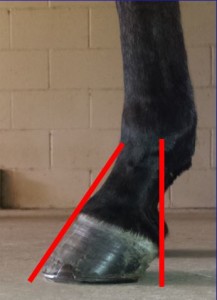
Now pick up your horse’s foot. When it is freshly trimmed the heels should be at the widest point of the frog. This is really, really, really important. Many of us where taught that heel should never be taken off. Like many things we heard in our youth, things changed. The heels must be at the widest point of the frog. Next draw a line across the widest part of the foot and a line at the toe. Half the foot should be in front of the widest point and half behind.

Draw a line down the center of the foot long ways and half the foot should be to the outside, half to the inside.

Set the foot back down and look at it from the front. A line drawn down the center of the hoof should divide the hoof in half with 50% to the inside, 50% to the outside.
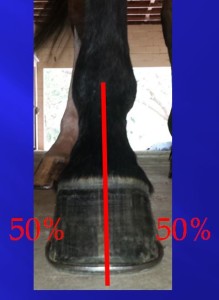
Hold your horse’s hoof up and let it hang from your hand. Draw a line down the center of the heels and again this should divide the hoof in half. This line should also be perpendicular to a line drawn across the heels where they will meet the ground. I hope you are noticing a pattern here. The foot should be symmetrical!

Notice none of this involved touching the sole with a hoof knife! By allowing our horses to form all the sole they want we help them keep good cushion beneath their coffin bone! Horses will naturally wear off any sole they don’t need so we don’t have to do that for them.
All this work has set us up for a discussion about the perfect break over, which is our real goal but you will have to wait until next week since I hear the full food bowl and clean litter box calling. Stay tuned. I will finish writing soon!

 A deeper understanding of the problem
A deeper understanding of the problem Put a shoe on it (or maybe not)
Put a shoe on it (or maybe not) New and Exciting stuff
New and Exciting stuff

 You humans have a thing you do with your middle finger. Horses one-up you: they walk on theirs! That’s right. The coffin bone is the tip of your middle finger. Feel the bones moving down your finger, back toward your hand, and you have the equivalent of the short pastern, long pastern, and cannon bone. You’ve got a navicular bone too, but only in your thumb. This whole ‘walking on one finger’ thing is why horses have so many lower leg problems.
You humans have a thing you do with your middle finger. Horses one-up you: they walk on theirs! That’s right. The coffin bone is the tip of your middle finger. Feel the bones moving down your finger, back toward your hand, and you have the equivalent of the short pastern, long pastern, and cannon bone. You’ve got a navicular bone too, but only in your thumb. This whole ‘walking on one finger’ thing is why horses have so many lower leg problems.
 Now why did I say in a freshly trimmed foot? Take a look at where the heel is located on this hoof. It’s nearly ¾” farther forward on the untrimmed side, when compared to the trimmed side. That’s not because the farrier did it wrong 5 weeks ago, that’s because the foot grew forward. It’s what they do.
Now why did I say in a freshly trimmed foot? Take a look at where the heel is located on this hoof. It’s nearly ¾” farther forward on the untrimmed side, when compared to the trimmed side. That’s not because the farrier did it wrong 5 weeks ago, that’s because the foot grew forward. It’s what they do. After assessing the bottom of the hoof, pick up the leg. Put your hand underneath the end of the cannon bone, and let the hoof hang. Notice there are no human hands in this picture. That’s they way it’s supposed to be! When you hang the hoof like this, a line drawn down the center of the pastern and heels should be perpendicular to the bottom of the hoof.
After assessing the bottom of the hoof, pick up the leg. Put your hand underneath the end of the cannon bone, and let the hoof hang. Notice there are no human hands in this picture. That’s they way it’s supposed to be! When you hang the hoof like this, a line drawn down the center of the pastern and heels should be perpendicular to the bottom of the hoof. 











